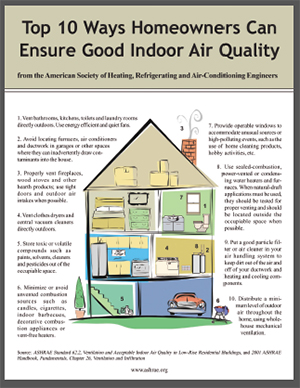Are concerns about indoor air quality making it difficult for you to breathe easy in your own home?
 VIEW THE PDF
VIEW THE PDF
Acknowledging reports that air quality inside homes can be worse than outside, engineers have identified ways to move air in and out of homes to minimize the factors that lead to indoor air quality problems.
The key is to design HVAC and other systems to work together to effectively ventilate homes and minimize sources of indoor pollution. Houses adhering to guidance from ASHRAE for home ventilation will generally result in increased indoor air quality and decreased health problems compared to those that do not. The guidance is contained in ASHRAE Standard 62.2, Ventilation and Acceptable Indoor Air Quality in Low-Rise Residential Buildings, is the only nationally recognized indoor air quality standard developed solely for residences. It is intended for use in building codes.
“The standard is just good, basic common sense,” Max Sherman, former chair of the committee that wrote the standard, said. “People need fresh air. The standard tells how to provide it and how to avoid other common problems.”
In the past, residential ventilation was not a major concern because it was felt people were getting enough outdoor air by opening their windows and by air leaking through the building’s walls.
As homes and duct systems were built tighter to save energy, trapping contaminants indoors, concern rose about indoor air quality, especially since people spend almost 90 percent of their day indoors — 65 percent of that in their homes. Also, residents are now less likely to open windows because of energy costs, security issues, drafts, noise and dirty air from outside.
Studies from the Environmental Protection Agency on human exposure to air pollutants show that indoor levels of pollutants may be two to five times, sometimes more than 100 times, higher than outdoor levels. People in buildings frequently report discomfort and building-related health symptoms, and sometimes develop building-related illnesses.
“Publication of this standard does not immediately require changes to building practice, but it does set the minimum level expected of HVAC professionals with respect to residential ventilation, and it should hopefully lead to changes in building codes,” Sherman said.
Some requirements in the standard that represent significant changes from standard practice include use of sound rated fans (because disruptively noisy fans are now commonly used) as well as use of mechanical, whole-house ventilation, which only a small fraction of houses currently use. The purpose of the standard is to provide the necessary building service of providing minimum acceptable indoor air quality, according to Sherman. A standard such as 62.2 benefits HVAC&R professionals and allied industries because it defines a demonstrable set of criteria for acceptability, which can be used to provide known value to the owner.
Although the standard is prepared for engineers who design HVAC systems in homes, there are several recommendations that can be applied by homeowners to their homes.